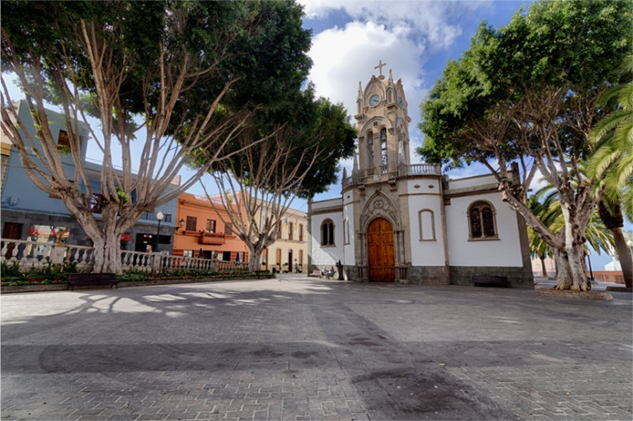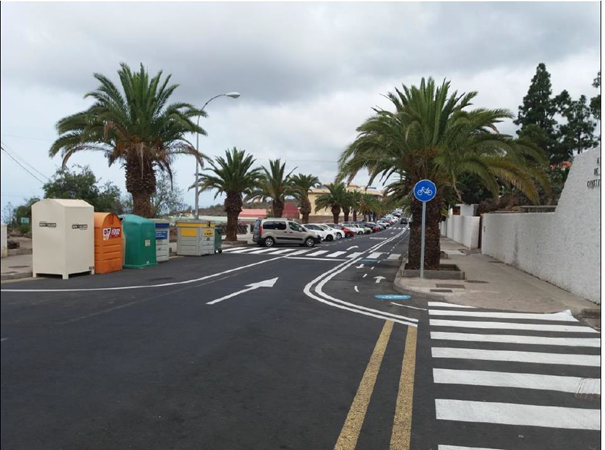The work of Guia de Isora for better public spaces to people
Edited on
23 August 2022Guía de Isora is located on the western slopes of the island of Tenerife and has a surface area of 143.43 km2, a perimeter of 52.42 km and a coastline of 14.35 km.
It has an estimated population of 21,796 inhabitants and represents 1% of the total population of the Canary Islands. This population is concentrated in a staggered manner from the midlands to the coastal area, where the greatest growth has been observed in recent years.

This municipality has 17 population centres distributed between the coast, the midlands and the highlands. The urban centres with the highest density and where most of the population is settled are Guía de Isora, the administrative capital of the municipality, Chío, Tejina, in the midlands, and Alcalá and Playa de San Juan on the coast. However, an important part of the population lives in rural areas such as Chiguergue, Aripe, Chirche, Acojeja, El Jaral, Las Fuentes and Vera de Erques, or in recent urbanised areas scattered around the midlands.
Challenges
One of the main strategic objectives of Guía de Isora Town Council is the promotion of sustainable urban mobility. This objective is based on the identification of various problems affecting the territory:
Problem 1. Difficulty of inter- and intra-urban mobility. Guía de Isora is the furthest municipality from the island's capital, 95 kilometres from Santa Cruz de Tenerife. In recent years there has been an increase in traffic in recent years. In addition, mobility has also been affected by the inefficient supply of public transport, which is based solely on the use of taxis and buses. There are 4 bus lines currently operating in the municipality, which have only 4 daily routes.
Problem 2. Prioritisation of private transport. The population of Guía de Isora prioritises the use of private vehicles to the detriment of public transport services, which causes heavy traffic congestion at certain times of the day and can increase problems of unsafety especially in areas close to schools and colleges.
Problem 3. Lack of safe cycling infrastructure. Currently, there are no bicycle lanes in the municipality that would allow these people to cycle safely (both for them and for the rest of the citizens) in the territory.
Problem 4. Parking difficulties in the Open Commercial Zones. In Guía de Isora there are 3 Open Commercial Zones (Guía de Isora Casco, Alcalá and Playa de San Juan). These are local commerce, as their customers are mainly residents of nearby areas and have an area of influence that encompasses the entire urban environment of the respective nucleus. However, a major weakness is the lack of parking, which is the main demand of entrepreneurs.
Problem 5. Lack of pedestrian and safe spaces. In the municipality of Guía de Isora there is a latent need to establish more places dedicated exclusively to pedestrians: small squares, promenades, pedestrian avenues, etc., which are safe and accessible, reducing the space dedicated to vehicles.
Objectives
The city of Guía de Isora has the following objectives to:
- be adapted to the needs of the community.
- improve the quality of life of the citizens.
- improve the environmental quality of the municipality.
- improve the safety of citizens.
- favour connectivity between population centres
- favour the municipality’s landscape
- allow the diversification in the use of means of transport: on foot, bicycle, bus, coach, etc.
If we analyse them as SMART objectives, the result is:
- To increase the efficiency of the use of public space for parking, which will lead to a 25% reduction in the surface area of land used for this purpose. This optimisation of existing space for parking will increase off-street parking capacities against drop of on-street.
- To achieve that in three years 50% of the centre of Guía de Isora Casco will be pedestrianised.
- To increase the number of pedestrian walkways by 20% in 3 years.
- To reduce the use of private vehicles in the municipality by 20% in two years.

In action
The Guía de Isora City Council has placed great value on the work at the local level, thus, it has created a local working group (URBACT Local Group - ULG) made up of the main stakeholders of the municipality. The URBACT Local Group allowed to give real answers to the problems of the municipality, having the experience and participation of people who work directly with the areas involved in the project. Thus, different ULGs were defined, with the aim of segmenting the stakeholders in different meetings, to deal with specific issues: Coordinator, Core and Extended ULG.
Currently, the City Council continues to develop actions at local level to promote sustainable mobility and the use of urban space, involving the citizens and talking about themes of interest. For example, through the organisation of workshops with the schools, or the organisation of forums to present the results of the Space4People project.
One element to highlight in the local work has been the drafting of the Integrated Action Plan for the improvement of urban mobility in Guía de Isora, which has allowed the definition of a road map with 14 actions framed in 7 themes of interest: roads, parking, pedestrian spaces, diversification of the offer, and communication, management, and participation. This document has been produced with the support of the ULG Coordinator and Core ULG C, based on 1) the results of a pilot test carried out in the municipality, 2) the problems and challenges facing the city analysed through diagnosis, 3) the responses of the multiple surveys made available to citizens, and, last but not least, 4) the meetings of the Extended ULG. The work at the local level has made it possible to understand the needs, visions and priorities of the stakeholders who may be affected by the urban politics.
From this work at the local level, the following can be highlighted as positive: the reception that both citizens and the ULG have given to the actions carried out on sustainable mobility and urban spaces; and the participation in the surveys, workshops, and meetings. On the negative side, the pandemic has meant that most of the events were held online. The face-to-face events are really the ones that generate an exchange between the parties and from which the most positive conclusions can be drawn.

Conclusions
The following conclusions can be drawn from the work carried out by the Municipality of Guía de Isora:
- It is necessary to create a small group to plan, guide the work and make decisions, although it should later be complemented by a larger group to enrich it.
- It is necessary to always involve citizens in the actions carried out in the city, given that they are the first actors to be affected. To this end, events should be organised, surveys should be carried out, etc., to find out their opinion. Small pilot tests of certain actions included in the IAP could even be considered in specific areas of the municipality, with the aim of finding out how well they are accepted by the citizens.
- Considering that the health situation has improved, it is important that face-to-face events return and include a small space (e.g., coffee break) for exchange and debate among participants.
- It is necessary to define which aspects of urban policy we want to focus on (roads, pedestrian areas, parking, etc.) and to define a particular strategy in each case, given that the problems and the actors involved are completely different.
Lessons learnt
Guía de Isora has been fortunate to be part of a network of European cities, each with a completely different profile, problems, resources and needs. This has allowed Guía de Isora Town Council to exchange knowledge with similar cities and share good practices. It is worth highlighting the learning about innovation in urban policies, which has inspired, to a large extent, the actions carried out by our municipality: both in the development of small-scale actions, as well as in the approach of the actions included in the integrated strategy. Some of the best practices that Guía de Isora has drawn inspiration from in the development of the road axes and pedestrian areas are as follows:
Jahnplatz - Bielefeld: Bielefeld decided to reduce individual motorised traffic on Jahnplatz to reduce air pollution and create a more liveable public square right in the heart of the city. To reduce the risk of mistakes and to address some controversial views on the necessary activities, Bielefeld implemented an extended pilot phase to test a new traffic scheme for Jahnplatz. This involved reducing the number of lanes for individual motorised vehicles and increasing the space dedicated to public transport and cyclists.
Wilhelmstraße - Bielefeld: Wilhelmstrasse runs between two main squares in Bielefeld city centre: Kesselbrink and Jahnplatz. Using the impulse of a research project called "Klimanetze" (climate networks), the Wilhelmstrasse ran a living laboratory: residents and local stakeholders had the opportunity to discuss what the street could look like in the future, and what its use would be. However, the most prominent aspect was to live through the possible change of the one-day pilot test, which closed Wilhelmstrasse to traffic and allowed all other possible forms of use.
Gürtelfrische West – Vienna: A swimming pool and various leisure time options were created with a programme such as dancing, workshops, talks and bike checks. The idea was to offer people the opportunity to go out during the COVID19 pandemic. Another aim of the project was to test the implications of closing the road to traffic in the area.
In addition, we consider that Guía de Isora has also been able to become a source of inspiration for the other partners of the network. As good practices, we find: our organisation of the local working group and its involvement determined by the type of issue to be discussed has undoubtedly been an element that has worked well in decision-making. Likewise, we also highlight the communication actions carried out by the municipality, in which the protagonist has always been the citizen and in which the aim has always been to obtain their opinion and suggestions. Finally, the structure of the IAP and the division by axe is a result that might be of use for other municipalities.
Submitted by Claus Kollinger on
